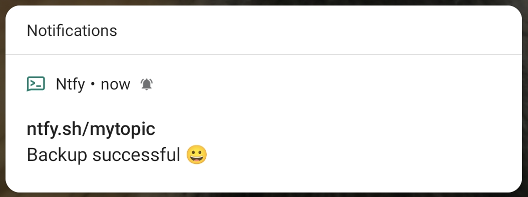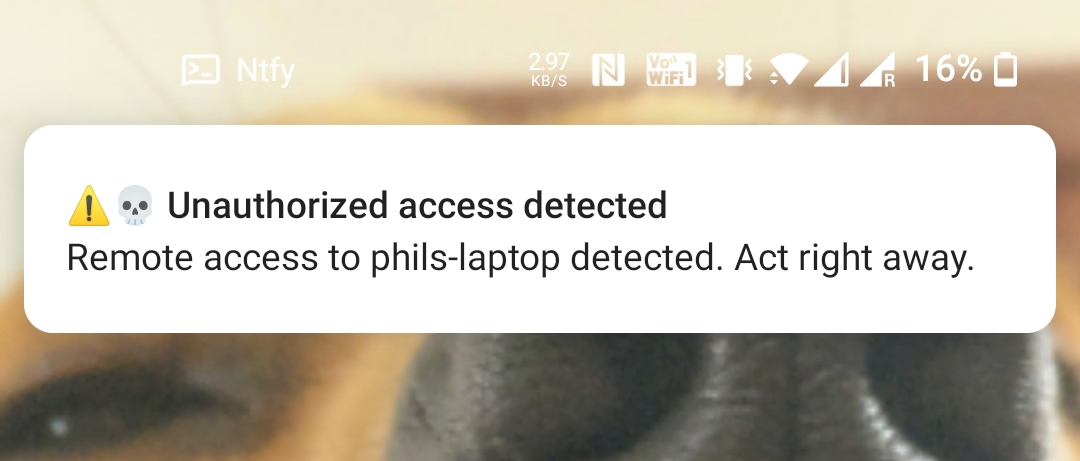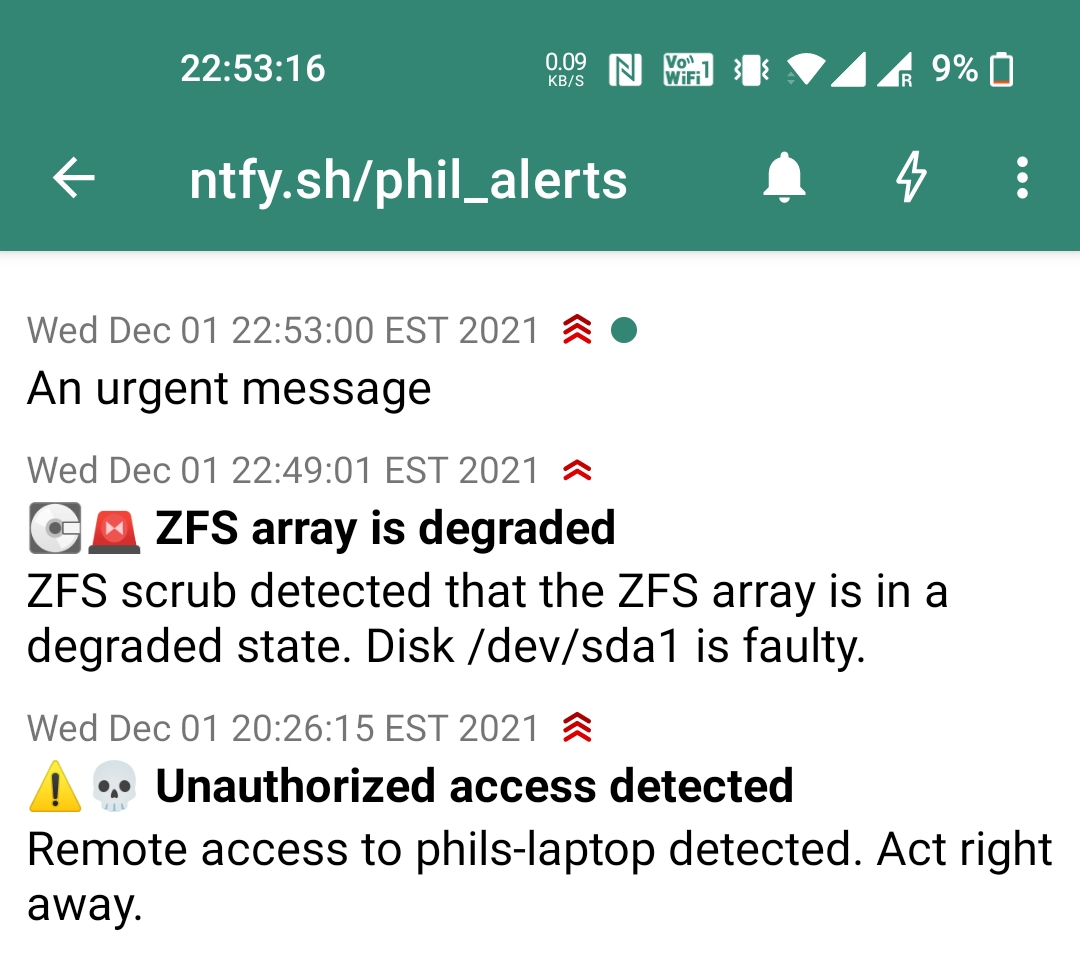# Publishing
Publishing messages can be done via PUT or POST. Topics are created on the fly by subscribing or publishing to them.
Because there is no sign-up, the topic is essentially a password, so pick something that's not easily guessable.
Here's an example showing how to publish a simple message using a POST request:
=== "Command line (curl)"
```
curl -d "Backup successful 😀" ntfy.sh/mytopic
```
=== "HTTP"
``` http
POST /mytopic HTTP/1.1
Host: ntfy.sh
Backup successful 😀
```
=== "JavaScript"
``` javascript
fetch('https://ntfy.sh/mytopic', {
method: 'POST', // PUT works too
body: 'Backup successful 😀'
})
```
=== "Go"
``` go
http.Post("https://ntfy.sh/mytopic", "text/plain",
strings.NewReader("Backup successful 😀"))
```
=== "PHP"
``` php
file_get_contents('https://ntfy.sh/mytopic', false, stream_context_create([
'http' => [
'method' => 'POST', // PUT also works
'header' => 'Content-Type: text/plain',
'content' => 'Backup successful 😀'
]
]));
```
If you have the [Android app](../subscribe/phone.md) installed on your phone, this will create a notification that looks like this:
{ width=500 }
Android notification
There are more features related to publishing messages: You can set a [notification priority](#message-priority),
a [title](#message-title), and [tag messages](#tags-emojis) 🥳 🎉. Here's an example that uses all of them at once:
=== "Command line (curl)"
```
curl \
-H "Title: Unauthorized access detected" \
-H "Priority: urgent" \
-H "Tags: warning,skull" \
-d "Remote access to phils-laptop detected. Act right away." \
ntfy.sh/phil_alerts
```
=== "HTTP"
``` http
POST /phil_alerts HTTP/1.1
Host: ntfy.sh
Title: Unauthorized access detected
Priority: urgent
Tags: warning,skull
Remote access to phils-laptop detected. Act right away.
```
=== "JavaScript"
``` javascript
fetch('https://ntfy.sh/phil_alerts', {
method: 'POST', // PUT works too
body: 'Remote access to phils-laptop detected. Act right away.',
headers: {
'Title': 'Unauthorized access detected',
'Priority': 'urgent',
'Tags': 'warning,skull'
}
})
```
=== "Go"
``` go
req, _ := http.NewRequest("POST", "https://ntfy.sh/phil_alerts",
strings.NewReader("Remote access to phils-laptop detected. Act right away."))
req.Header.Set("Title", "Unauthorized access detected")
req.Header.Set("Priority", "urgent")
req.Header.Set("Tags", "warning,skull")
http.DefaultClient.Do(req)
```
=== "PHP"
``` php
file_get_contents('https://ntfy.sh/phil_alerts', false, stream_context_create([
'http' => [
'method' => 'POST', // PUT also works
'header' =>
"Content-Type: text/plain\r\n" .
"Title: Unauthorized access detected\r\n" .
"Priority: urgent\r\n" .
"Tags: warning,skull",
'content' => 'Remote access to phils-laptop detected. Act right away.'
]
]));
```
{ width=500 }
Urgent notification with tags and title
## Message priority
All messages have a priority, which defines how urgently your phone notifies you. You can set custom
notification sounds and vibration patterns on your phone to map to these priorities (see [Android config](../subscribe/phone.md)).
The following priorities exist:
| Priority | Icon | ID | Name | Description |
|---|---|---|---|---|
| Max priority |  | `5` | `max`/`urgent` | Really long vibration bursts, default notification sound with a pop-over notification. |
| High priority |  | `4` | `high` | Long vibration burst, default notification sound with a pop-over notification. |
| **Default priority** | *(none)* | `3` | `default` | Short default vibration and sound. Default notification behavior. |
| Low priority |  |`2` | `low` | No vibration or sound. Notification will not visibly show up until notification drawer is pulled down. |
| Min priority |  | `1` | `min` | No vibration or sound. The notification will be under the fold in "Other notifications". |
You can set the priority with the header `X-Priority` (or any of its aliases: `Priority`, `prio`, or `p`).
=== "Command line (curl)"
```
curl -H "X-Priority: 5" -d "An urgent message" ntfy.sh/phil_alerts
curl -H "Priority: low" -d "Low priority message" ntfy.sh/phil_alerts
curl -H p:4 -d "A high priority message" ntfy.sh/phil_alerts
```
=== "HTTP"
``` http
POST /phil_alerts HTTP/1.1
Host: ntfy.sh
Priority: 5
An urgent message
```
=== "JavaScript"
``` javascript
fetch('https://ntfy.sh/phil_alerts', {
method: 'POST',
body: 'An urgent message',
headers: { 'Priority': '5' }
})
```
=== "Go"
``` go
req, _ := http.NewRequest("POST", "https://ntfy.sh/phil_alerts", strings.NewReader("An urgent message"))
req.Header.Set("Priority", "5")
http.DefaultClient.Do(req)
```
=== "PHP"
``` php
file_get_contents('https://ntfy.sh/phil_alerts', false, stream_context_create([
'http' => [
'method' => 'POST',
'header' =>
"Content-Type: text/plain\r\n" .
"Priority: 5",
'content' => 'An urgent message'
]
]));
```
{ width=500 }
Detail view of priority notifications
## Tags & emojis 🥳 🎉
You can tag messages with emojis (or other relevant strings). If a tag matches a known emoji short code,
it will be converted to an emoji. If it doesn't match, it will be listed below the notification. This is useful
for things like warnings and such (⚠️, ️🚨, or 🚩), but also to simply tag messages otherwise (e.g. which script the
message came from, ...).
You can set tags with the `X-Tags` header (or any of its aliases: `Tags`, or `ta`).
Use this reference
to figure out what tags can be converted to emojis. In the example below, the tag "warning" matches the emoji ⚠️,
the tag "ssh-login" doesn't match and will be displayed below the message.
```
$ curl -H "Tags: warning,ssh-login" -d "Unauthorized SSH access" ntfy.sh/mytopic
{"id":"ZEIwjfHlSS",...,"tags":["warning","ssh-login"],"message":"Unauthorized SSH access"}
```
## Message title
The notification title is typically set to the topic short URL (e.g. `ntfy.sh/mytopic`.
To override it, you can set the `X-Title` header (or any of its aliases: `Title`, `ti`, or `t`).
```
curl -H "Title: Dogs are better than cats" -d "Oh my ..." ntfy.sh/mytopic<
```